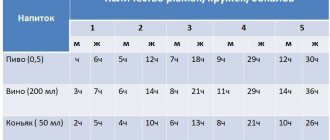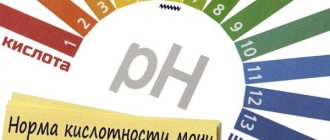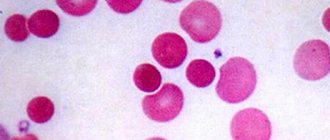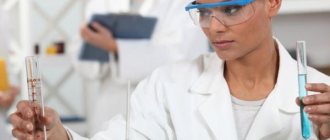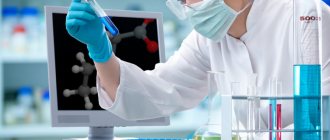Medical achievements amaze us with their scale every time. Just a few decades ago it was not yet possible to reliably determine even the sex of a child during pregnancy, but today medicine has stepped far forward.
Thanks to scientific discoveries, you can establish paternity, evaluate blood composition, and also learn about your ancestors.
Genetic testing allows you to determine nationality using a special test.
What is DNA and what are its functions?
Let's start with the fact that each human cell is a complex structured element consisting of many units. In the center of the cell is the nucleus - the largest organelle in which DNA molecules - deoxyribonucleic acid - are stored. Some DNA is also stored in the membrane and mitochondria.
Reference! If you imagine a cell in the form of a fried egg, then the yolk is the nucleus that stores genetic information.
A DNA molecule consists of two chains of nucleotides twisted together:
- A specific section of a molecule is a gene.
- A gene includes a strict number of nucleotides located in a specific location.
For example, the gene that encodes the synthesis of insulin consists of 60 nucleotide pairs, oxytocin - of 370 pairs.
All genetic material is contained in 46 DNA molecules.
One pair of molecules is called a chromosome. Each chromosome carries certain information, which determines the appearance and character of a person. Sex cells have 23 pairs of chromosomes. That is why, when they are combined, the child inherits some of the characteristics from the father, and some from the mother.
Attention! Thus, the main functions of DNA are storage and transmission of information.
The video explains what DNA is and what its functions are:
Expertise capabilities
In 2003, scientists made a statement: it is now possible to decipher all the DNA molecules contained in the 23 pairs of human chromosomes. This opens up enormous prospects for the development of genetics as a science. Thus, in a number of countries they are already searching for genes predisposed to cancer.
For example, thanks to genetic research you can:
- Identify hereditary predisposition to a number of diseases;
- Genetic pathologies that cause diseases of unknown origin (when the etiology is not established using other diagnostic methods);
- Calculate intolerance to certain medications and components;
- Establish relationship (paternity, maternity and other connections);
- Tendency to alcoholism and drug addiction;
- Establish possible risks during physical activity (which is very important for professional athletes);
- Possible causes of infertility;
- Identify allergic reactions (predisposition to allergies);
- Establish a predisposition to excess weight;
- Identify monogenic mutations;
- Diagnose infectious diseases;
- Determine belonging to a specific ethnic group.
- Take a DNA nationality test
Using genetic testing, it is possible to determine the nationality of people in 350 regions.
This is possible by comparing the characteristics of the chromosomes of the person under study and the intended ethnic group. DNA also reflects mutations characteristic of a particular people.
Important! The test is particularly accurate because DNA contains complete information about several generations of people.
There are three types of genetic DNA tests that determine ancestry:
- Autosomal analysis - study of all branches of the family tree;
- Mitochondrial analysis - study of the maternal line;
- Test Y - establishing paternity.
It is genealogical tests that do not allow drawing conclusions regarding health, but open up other possibilities:
- Determination of family ties within 5-6 generations;
- Percentage of belonging to different ethnic groups;
- Kinship over several decades or centuries;
- A person's race.
DNA testing is carried out using 175 SNP markers. Characteristics of a specific allele are identified, which show membership in a specific ethnic group as a percentage.
Reference! In this way, you can determine the number of relatives from a certain region in a family. As a rule, 100% “pure” belonging to a nationality does not occur; a combination of several ethnic groups is always revealed.
The video explains what genetic analysis is and what it can tell you:
Who will need the test?
In what cases is Jewishness analysis required:
- When a child was born out of wedlock to a Jew and a non-Jew or too much time has passed, in the opinion of the Israeli Ministry of Internal Affairs, between the fact of childbirth and the registration of a legal union. In order for a child to receive citizenship, proof is required that he is really the child of this man. This procedure is not as simple as it seems. In Israel, court approval is required to conduct tests on a child. To prove Jewishness through genetic analysis, the child’s father should submit a corresponding application to the prosecutor’s office, which, in turn, sends the case to court. If the latter has authorized a DNA test for Jewishness, then it is necessary to deliver saliva samples of the father and child to the laboratory.
It is important to know: the testing itself is carried out exclusively in Israel, but it is not worth bringing the mother and child to the country for this. Most likely, they will be deployed at the border. Israeli bureaucrats have the mistaken opinion that if a woman and a child come to the country, it will be difficult to deport them from it.
- DNA confirmation of Jewishness can also help those who have little documentary evidence of their Jewish identity. But this is not exactly a test for Jewishness, since in this case the DNA of people who are, albeit distantly related, is compared. For example, this applies to stepchildren. If one child has Jewishness at birth or a more complete set of documents identifying him as a descendant of Jews, and the second does not, then Jewishness can be proven by testing the latter’s blood by determining that they are relatives. A similar analysis is accepted in all authorities that deal with issues of granting Israeli citizenship.
In other cases, conducting such tests is just a way to find out whether there is at least a small percentage of Jewish blood in the blood, so that you can then begin to study your family tree and collect bit by bit documentary evidence of nationality.
Materials for examination
Almost any biological material is suitable for clinical and genealogical analysis:
- bone,
- blood,
- saliva,
- nails,
- hair,
- sperm,
- earwax.
As a rule, an oral swab or scraping of the buccal epithelium is more often used for examination. But the predominant material for the study is dictated by the clinic in which the analysis is performed, as it is determined by the type of reagent and type of equipment.
Reference! Chewing gum, a cigarette butt, a cocktail straw, a comb, a razor, a toothbrush and a baby's pacifier may be suitable for examination.
How to independently obtain DNA samples for research is described in the video:
Picking up and sending material
The easiest way to test the genetic material is in a laboratory, but you can collect it yourself. Typically, clinics and laboratories offer confidential testing with high accuracy.
Busy people can use the service of sending a DNA sample by mail and receiving the result.
Rules for self-sampling
To obtain genetic material without the help of a specialist, you will need cotton swabs and envelopes.
What is the procedure for obtaining a sample?
- Each envelope is signed with the subject's name;
- Before taking an oral swab, you need to rinse your mouth with clean boiled water;
- It is necessary to take a cotton swab by one end, place the other in your mouth in the space between the gum and cheek and move it, twisting the cotton swab so that a sample of saliva remains on it;
- Carefully cut off the side of the stick that acted as a handle. The remaining end with the biomaterial is placed in an envelope and sealed.
Reference! Materials from different people should not be placed in one envelope; this may distort the result.
After collecting the material, the envelope is handed over to the courier or independently handed over to the laboratory assistant at the clinic.
Watch a video that shows how people react when they find out what nationality they are by taking a DNA test:
Where to submit samples for DNA analysis for ethnicity in Moscow
There are different ways to donate DNA samples for paternity and relationship:
- At the point for receiving samples from our laboratory at any time convenient for you. But for convenience, you can reserve a specific date and time using pre-registration.
- Do it yourself: using cotton swabs purchased at your nearest pharmacy (you can use standard ear cotton swabs).
- Do it yourself: with a free Ralzo kit specially designed for collecting DNA samples yourself.
- Using a free courier order.
Clinics
Currently, finding a clinic that would decipher genetic material is not so easy. However, they exist and are ready to provide the necessary service in good quality.
Moscow
- Center for Genetic Research Lab DNK. Genealogical tests are performed in different directions: test for ethnic origin, family origin, nationality, paternal and maternal genealogy. Features: result in 7-25 days, accuracy 99.999%, cost - 9900 rubles. Promotions are held regularly. Anonymity guaranteed.
- Molecular genetic. The cost of a DNA examination to determine nationality is 7,900 rubles, deciphering the results from another clinic is 4,900 rubles. The center is open daily from 9:00 to 22:00.
- Genotek Clinic. One of the clinic’s features is the ability to order a test online or by phone and receive results from any city in Russia or any other country. With this service, a special complex for collecting biomaterial is provided. The cost of the study is 19,900 rubles.
- Molecular genetic laboratory Ralzo. Using high-precision equipment, nationality is established with an accuracy of 100%. Price - 7900 rubles.
- The DDC diagnostic center provides services for establishing nationality, carries out a full ethno-geographical analysis, ethnic analysis and search for relatives, analysis of Jewish markers, analysis of paternal and maternal lines. The cost of various examinations varies from 6,900 to 28,900 rubles.
Reviews about these clinics are very good.
Saint Petersburg
- The DDC diagnostic center provides services for establishing nationality, carries out a full ethno-geographical analysis, ethnic analysis and search for relatives, analysis of Jewish markers, analysis of paternal and maternal lines. The cost of various examinations varies from 6,900 to 28,900 rubles.
- Center for Genetic Research Lab DNK. Genealogical tests are performed in different directions: a test for ethnicity, for the origin of a family, for nationality, for genealogy on the paternal and maternal lines. Features: result in 7-25 days, accuracy 99.999%, cost - 9900 rubles. Promotions are held regularly. Anonymity guaranteed.
- Nucleus Laboratory. All types of DNA examinations are carried out, the cost of each is from 8,000 to 16,000 rubles. High accuracy, ability to order research online, detailed research report.
- Genetic laboratory Medical Genomics. All types of analyzes are carried out using standard biomaterial (saliva) and non-standard ones. Diagnostic accuracy is up to 100%. Possibility of urgent analysis within up to 5 days. The service of taking samples at home and courier delivery of samples is provided. The cost of analysis is calculated individually.
- Molecular genetic. The cost of a DNA examination to determine nationality is 7,900 rubles, deciphering the results from another clinic is 4,900 rubles. The center is open daily from 9:00 to 22:00.
How long does it take to study a sample?
The timing of genetic research depends on the type of biomaterial, the method of its collection and the method of analysis. Molecular genetic studies take 7-10 days from the moment the material arrives at the laboratory, and the duration of analysis using the FISH method is from 3 to 14 days, depending on the purpose. Cytogenetic studies take on average from 10 to 23 days.
The material is collected directly in the clinic or at home. To do this, the medical center to which you apply for the service sends by mail a special sterile container for collecting the material. In this way, you can send saliva, blood and other types of biomaterials. In such cases, the waiting time for results increases due to delivery times.
Stages of a genetic test
DNA testing is carried out in stages.
The obtained genetic material is examined by a geneticist together with a laboratory assistant, having previously released the DNA chains.
The key is the structure and arrangement of the molecules.
Certain sections of the chain identified in the patient are compared with the results of standards collected in the haplotype reference database (a set of alleles on jointly inherited chromosomes). Haplotypes are collected in accordance with certain population groups - ethnic ones, with which connections are maintained along the maternal and paternal lines.
A haplogroup is a large group of people who share the same ancestor. The determination of a haplogroup is based on the identification of a specific haplotype.
Those sections of DNA that coincide with sections characteristic of specific nations make it possible to ascertain the history of the genus.
Reference! The most detailed decoding is required if a person has a mixed origin. In this case, the results are provided as percentages that demonstrate the ratio of genes of different peoples.
Scientific background
It has long been known that each person has his own unique genetic code, which is obtained as a result of the interweaving of paternal and maternal characteristics.
There is also information that is inherited from one of the parents without any changes at all, and this greatly simplifies the procedure for determining nationality.
According to historical data, in a relatively recent time from an evolutionary point of view, it was considered the norm to marry members of one’s family:
- People living in the same territory became spouses, and they could be first or second cousins.
- As a result, the genome (the set of genes of one organism) of people who lived in the same territory for a long period of time acquired its own distinctive features under the influence of random mutations.
Reference! Experts spent many years trying to establish these features of each haplogroup and identify its ancestor. When a person who has come to take a nationality test has a DNA section that matches one of the studied haplogroups, he is considered a descendant of this ancestor, nationality, or ethnic group.
What genes are passed on to us by our relatives is explained in the video:
Unknown matches
I ordered DNA testing for myself and my relatives - therefore, in the list of “matches” (people with common DNA fragments), the first, “best” places are occupied by them. I wonder if the test will reveal relatives unknown to me?
Unfortunately, not many people have done DNA testing, especially from the post-Soviet space. But matches can only be with those who passed the test. It doesn't seem like much to expect, but my experience suggests otherwise. For example, my father according to the FamilyTreeDNA
there are 930 matches, of which only the first 4 are known relatives.
MyHeritage
talks about 2724 matches found, there are 96 in the
geni.com
, and finally
gedmatch
shows the first 3000 - it is unknown how many there are in total. Other tested people have approximately the same number of matches.
Despite the huge number of relatives found, identifying who the common ancestor is is often very difficult. Two persons with common DNA fragments must know the pedigree up to the 5th-6th generation along all lines. The task is greatly simplified when both matches have the same surname in their ancestors. Sometimes a common geographic past helps. For example, if the ancestors of both matches lived in the same or neighboring villages, that is where one should look for a common ancestor.
Speaking of matches, I mentioned various bases
.
This is really the problem with DNA testing. When taking tests in one company, you are looking for relatives only among those who also took the test in this company. Fortunately, there is a solution to this problem
-
it is often possible to transfer DNA testing results from one database to another.
There is also a free and very popular resource
gedmatch
, whose main task is to store test results from all companies. I will review various companies and their tests in another post.
Price
Despite the great achievements of medicine, DNA testing to determine nationality still remains a complex multi-stage procedure, and therefore the cost of the study is quite high.
The specific price can only be determined during an individual visit. It is necessary to find out how much work will be carried out, how accurate the results are expected by the client and how many genes will be studied, and, accordingly, how much data needs to be deciphered. By the way, the timing of the study also depends on this.
How much does this analysis cost? If the object of research is one gene, the price can start from a thousand rubles. A complete genetic examination will cost several hundred thousand rubles.
Attention! The average cost of genealogical analysis is about 10,000-15,000 rubles.
What is the cost of analysis?
- The amount of genetic information that needs to be read and deciphered;
- Selected research method;
- Type of biomaterial (saliva, blood, bone tissue, etc.);
- Limited time frame (the more urgently the result is needed, the higher the cost);
- Status and policy of the clinic;
- Need for equipment and reagents.
For example, it is much easier to analyze saliva than other biomaterials; accordingly, the price for examining hair or toothbrush material will be higher.
Price
Depending on the complexity of the analysis, the price of a genetic study will vary from 500 rubles. and higher. In private laboratories, the average cost of analysis for one disease is 2-5 thousand rubles. There are companies that provide comprehensive genome diagnostics in several areas at once:
| Company name | Directions in testing | Where is | price, rub. |
| Genotek |
| Russia Moscow | one analysis – from 20 thousand, complete decoding of the genome – 375 thousand. |
| My gene |
| Russia, Yekaterinburg | one analysis – from 30 thousand. |
| Atlas |
| Russia Moscow | analysis in all areas – 30 thousand. |
| Lifegen |
| USA, with representative office in Russia | 30 000 – 70 000 |
| MyGenetics |
| Novosibirsk, Russia | from 4900 to 30 000 |
| yRisk | predisposition to hereditary forms of cancer | Russia Moscow | 35 000 |
| 23andMe |
| USA | 199$ |
Researching the human genome is a labor-intensive and often expensive process, but it is completely worth it. Genetic testing is used to assess susceptibility to disease, sensitivity to medications, and identify potential causes of unusual body responses.
Deadlines
It is almost impossible to get results the next day after submitting the material: the average study period is 3-4 weeks.
It may well be reduced or increased several times. For example, sometimes samples need to be sent to another laboratory that has more suitable equipment and the necessary reagents.
Attention! The period also depends on the amount of work. It is possible to decipher several dozen DNA elements, or several million microscopic structures.
All this is interesting. But it’s probably expensive and painful?
Today there are many companies that offer their DNA testing services. The generally recognized leaders in this field are the FamilyTreeDNA
,
23andme
,
Ancestry
,
MyHeritage
and some others. There are also Russian companies offering similar services.
The products of each company have their own specifics, I will write more about this in a separate note. For example, FTDNA offers Y-chromosome and mt-DNA testing, while the main feature of 23andme tests is medical DNA testing. Ancestry historically has the largest database of people tested, and so on.
In recent years, prices for tests have tended to decrease. An autosomal test costs on average $70-80, plus $5-10 for mail delivery of the test. Several times a year, each company offers discounts on a specific range of products - for example, in honor of Mother's Day, discounts on mt tests. On such days, the autosome test is reduced to $59, and on Black Friday in 2020 it cost 39$
, and delivery was free for a couple of days.
In short, by waiting for Black Friday, you can get the result of your DNA testing at FTDNA for $40
, and taking advantage of other discounts - for $55-65.
Fears that the process of donating DNA itself is something unpleasant are also unfounded. Although each company offers its own method of obtaining DNA, its essence boils down to a simple “spit” in a cone
that was sent by mail, and sending the cone in an envelope back to the laboratory. Of course, this is a very rough approximation - for example, some companies ask you to rub the inside of your cheeks with a cotton pad, which you then put into a cone - but in general it is still the same simple procedure. Detailed instructions for taking the test will be given in a separate note.
Y- and mt-chromosome tests have a wide range of prices, depending on how much detail the chromosome is examined. This is a separate, broad topic that will be described in detail in a separate note.
The essence of the study
Specialists in the field of genetics rely on the knowledge accumulated in the field of gene geography .
Reference! This is an industry that is at the intersection of geography, genetics and history, which allows us to track the migrations of peoples.
The key point is the fact that approximately once every 10-15 thousand years mutations occur in DNA that determine genetic branching. After studying the mutations of different nationalities, it became possible to draw maps of the movements of all haploid groups.
The importance of genealogy for science as a whole is enormous.
DNA genealogy allows us to put forward hypotheses regarding the emergence of the human race, its migration and division into separate ethnic groups and nationalities.
In the field of medicine, accumulated knowledge can be used to diagnose and prevent many mutations and hereditary diseases. Opportunities are opening up to find out the deeper causes of a number of diseases, and as a result, to develop more effective methods of diagnosis and treatment.
For example, a huge discovery was the ability of genetic engineering to isolate individual sections of a DNA molecule and multiply it, and with the help of gene therapy, only healthy genes can be isolated and introduced into the affected areas.
How it is used in medicine
Probably the most scandalous way of using PCR in medicine, which still causes storms of indignation and conflicts in society, is the establishment of biological relationships, or genetic diagnostics.
The most promising area of application of this method is the identification of hereditary diseases with the aim of subsequently combating the disease, or genomic diagnostics.
The most “mystical” and shrouded in mystery side of the use of PCR is the successful use of the technique for cloning experiments.
Interesting Facts
- A man's DNA contains information about both parents, while women only have information about their mother's side. Therefore, to examine a woman, biological material from her father is required.
- The result of a DNA ancestry test will contain the test subject's haplogroup, which represents the place in the world where his ancestors came from, down to the time and place of formation of the haploid group.
- Maps of the distribution of genetic mutations have now been created. Based on such data, the doctor can prescribe the most optimal treatment, taking into account the individual response to certain drugs.
- About once every 10–15 thousand years, mutations form in DNA, which allow one genetic branch to be separated from another.
- Many scientists are confident that the common female ancestor of all humankind existed approximately 160 thousand years ago in Africa, and the male ancestor - 130 thousand years ago in the same region.
- The most common haplogroups in Russia belong to the Tatars and Slavs.
- Specialists from California are currently working on creating a new social network that will allow its users to compare DNA sequences. To do this, you need to purchase a special test tube, place saliva in it and send it to the company’s specialists for examination.
- DNA analysis allows you to identify belonging to the European, East Asian, African, and Southeast groups.
- Genetic information about ancestors is stored on the Y chromosome (male).
- There is a special hard drive, which, in the event of an irreversible global catastrophe, is designed to preserve and transmit for descendants the DNA of people such as Lance Armstrong, Stephen Hawking and other famous personalities.
- Scientists from Britain conducted an interesting experiment and decomposed the DNA molecule chain into notes. The chamber choir performed this so-called “song of life.”
The video shows 18 interesting facts about genetics:
Thus, now every person can find out his belonging to a particular nationality, and this will take no more than a month.
Sometimes this analysis is nothing more than interest, and sometimes it is a necessity. Many Russian cities have their own clinics that allow genealogical research. A service has also been developed for collecting and transporting material to other cities and receiving results by courier.




